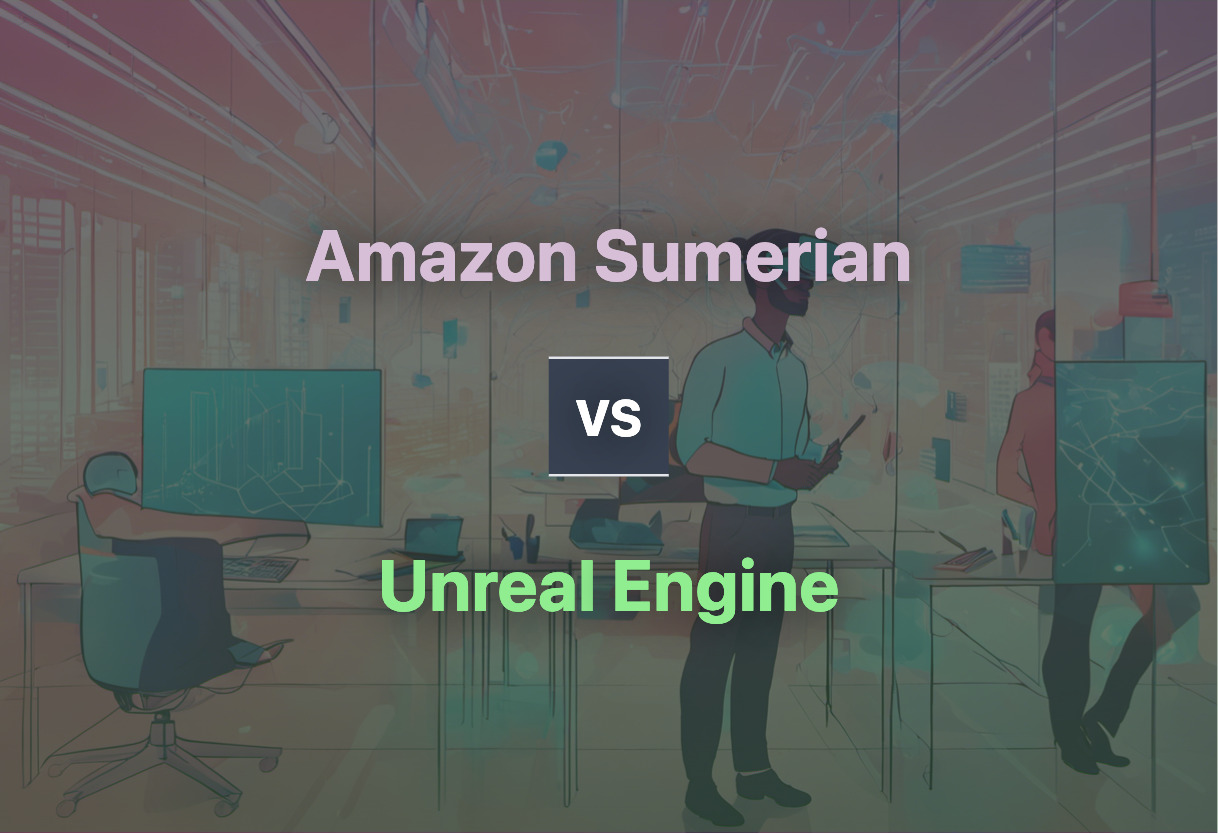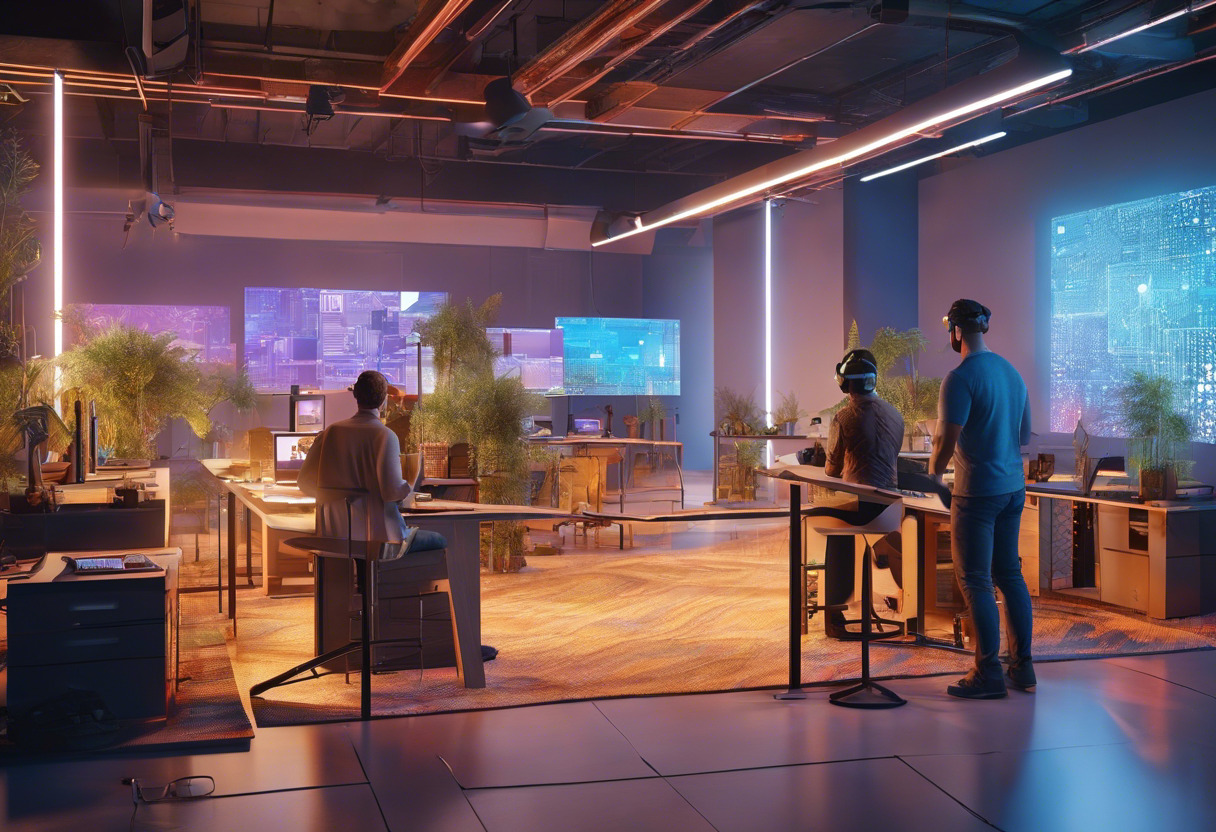For novice developers keen to dive into AR/VR, Amazon Sumerian‘s user-friendly, AWS-integrated platform can be a tempting option. However, with its discontinuation imminent, developers seeking a long-term, robust and highly flexible solution should consider the Unreal Engine, despite its complex learning curve.

Key Differences Between Amazon Sumerian and Unreal Engine
- Availability: Amazon Sumerian is discontinuing and recommends users transition to Babylon.js. Unreal Engine is still actively developed by Epic Games.
- Cost: Sumerian charges based on the total size of 3D assets and views per month. Unreal Engine is free, but charges 5% of revenue for products making over $1 million.
- Language: Sumerian uses JavaScript for scripting, Unreal Engine primarily uses C++.
- Integrations: Sumerian integrates closely with other AWS services. Unreal Engine does not offer similar AWS integration but provides extensive customizability.
- User Base: Sumerian aimed at enterprises lacking in-house VR/AR talents. Unreal Engine has a broader user base, spanning game development to film and TV.
| Comparison | Amazon Sumerian | Unreal Engine |
|---|---|---|
| Accessibility for New Customers | Unavailable from May 18, 2022 | Currently Available |
| Availability for Existing Customers | Accessible till February 21, 2023 | Continual Access |
| Purpose | Creation, building, running of AR, VR, 3D applications | Primarily for game development, also used in film and television |
| Language | JavaScript | C++ |
| Initial Release | No official release date provided | First seen in 1998 |
| Cost | Free trial, then charge based on total size of 3D assets and views per month | Free for revenues under USD 1 million, 5% charges for revenues above |
| Experience for Developers | Designed for developers with no prior experience in VR, AR, 3D applications | Requires knowledge in C++ |
| Platform Support | WebGL, WebVR, Oculus Rift, HTC Vive, iOS, Android ARCore | Desktop, mobile, console, and virtual reality platforms |
| Integration | Integrated with Amazon Lex, Polly, AWS Lambda, AWS IoT, Amazon DynamoDB | Includes features from acquired companies like Quixel |
What Is Amazon Sumerian and Who’s It For?
Amazon Sumerian is a cloud service designed for creating, building, and running AR, VR, and 3D applications seamlessly. It aids developers lacking VR, AR, and 3D experience and targets enterprises without in-house expertise to handle new tech. Also used in training, visualizing financial modeling, and customer relations, Sumerian offers a comprehensive suite of intuitive tools and resources that work across multiple platforms.
Though unavailable to new customers from May 18, 2022, and existing customers’ Sumerian data will only be accessible till February 21, 2023. The company recommends transitioning scenes to Babylon.js for publication via AWS Amplify.

Pros of Amazon Sumerian
- Intuitive tools for creating AR, VR, 3D applications
- Integrated with Amazon Polly and Amazon Lex
- Targets enterprises lacking in-house tech talents
- Host customization options for gender, voice, language
- Accessible 3D experience anywhere via AWS Amplify
Cons of Amazon Sumerian
- Unavailable to new customers from May 2022
- Existing customer data accessible till Feb 2023 only
- Charge based on total size of 3D assets and views per month after free trial
What Is Unreal Engine and Who’s It For?
Unreal Engine (UE) is a suite of 3D computer graphics game engines by Epic Games. Initially for PC first-person shooters, it now caters to various game genres and industries, including film and television. The engine supports a wide variety of platforms, including desktop, mobile, console, and virtual reality platforms and is written in C++.
The latest release, Unreal Engine 5 (UE5), launched in April 2022. Though free for schools and universities, Epic charges 5% of revenues over USD 1 million for commercial use, which is waived for games published on the Epic Games Store.

Pros of Unreal Engine
- Supports a wide range of platforms
- Level editor supports real-time constructive solid geometry operations
- Wide use in various industries
- 88% revenue share for content creators on Unreal Marketplace
- Free for academic institutions
Cons of Unreal Engine
- 5% charges on revenues over USD 1 million
- The programming language for development is only C++
Code Examples for Amazon Sumerian & Unreal Engine
Amazon Sumerian
In this Amazon Sumerian example, we’ll use JavaScript to create an interactive sphere using Scene, Entity, Transform, and SphereRenderer systems. Ensure the Amazon Sumerian SDK is installed and ready. Don’t forget to replace ‘mysphere’ and ‘myscene’ with your desired IDS.
// Import required systems
const { Scene, Entity, Transform, SphereRenderer } = require('amazon-sumerian-sdk');
// Create a new scene
let myScene = new Scene('myscene');
// Create a new entity with transform and sphere renderer components
let mySphere = new Entity('mysphere')
.addComponent(new Transform({
position: [0, 0, 0],
rotation: [0, 0, 0, 1],
scale: [1, 1, 1]
}))
.addComponent(new SphereRenderer());
// Add the sphere entity to the scene
myScene.addEntity(mySphere);Unreal Engine
Now, in this Unreal Engine example, we’ll make use of Blueprint Visual Scripting to spawn and control objects. Be sure that the Unreal Engine Blueprint system is set up correctly before proceeding. The written lines of code, or nodes, form a neat blueprint to spawn a simple object and control its visibility.
// Variables specifying the desired object and transform.
UPROPERTY(EditAnywhere, Category = "Spawning")
TSubclassOf<AActor> ActorToSpawn;
UPROPERTY(EditAnywhere, Category = "Spawning")
FTransform SpawnTransform;
// Our spawn function
UFUNCTION(BlueprintCallable, Category = "Spawning")
AActor* SpawnActor();
// The function definition in our .cpp file
AActor* UMySpawner::SpawnActor()
{
return GetWorld()->SpawnActor<AActor>(ActorToSpawn, SpawnTransform);
}
// Change object's visibility
UFUNCTION(BlueprintCallable, Category = "Visibility")
void ChangeVisibility(AActor* Actor, bool bNewVisibility);
void UMySpawner::ChangeVisibility(AActor* Actor, bool bNewVisibility)
{
Actor->SetActorHiddenInGame(!bNewVisibility);
}Which Reigns Supreme? Amazon Sumerian or Unreal Engine?
In the clash of AR/VR giants, it all boils down to your specific needs. Let’s analyze.
Developers New to AR/VR
Amazon Sumerian is a perfect catch. Easy-to-use, intuitive, and requiring no prior VR/AR experience, it enables quick VR development. Supports WebGL, WebVR, Oculus Rift, HTC Vive, iOS, Android ARCore, with Oculus Go in pipeline.

Enterprise AR/VR with a Scaling Need
Unreal Engine perfectly caters to your needs. It supports a range of platforms, including desktop, mobile, console, VR, and offers flexible royalty models, ideal for scaling businesses.

Advanced AR/VR Developers
For complex projects requiring advanced physics and animation, Unreal Engine beats Sumerian with its powerful C++ environment and vast tools library.

AR/VR Start-ups with Limited Talent Base
Amazon Sumerian clearly wins. Designed specifically for enterprises lacking in VR/AR, offers a suite of pre-built objects, scripts and third-party integrations.

When tackling AR/VR, consider the need for simplicity versus power. Amazon Sumerian simplifies creation while Unreal Engine caters to nuanced, high-performance projects. Decision lies in your goal’s complexity.
Patrick Daugherty
Content writer @ Aircada. Merging AR expertise with a love for late-night gaming sessions.





